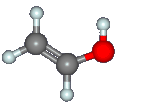|
Vinyl alcohol (CH2CHOH) was
discovered in 2001 in
Sgr B2(N) by
Turner & Apponi using the 12 m telescope at
Kitt Peak National Observatory. The report notes that lines for
both the anti and syn conformations of vinyl alcohol were observed. The detection has evidently
not been confirmed to date by subsequent observations.
Vinyl alcohol (or ethenol) is the least
stable of the three C2H4O isomers, which also include the known astromolecules
acetaldehyde and ethylene oxide. While vinyl
alcohol can rearrange (tautomerize) into acetaldehyde,
too much energy is required for this to occur in the
gas phase at low temperature, so vinyl alcohol has a long lifetime in the ISM once it is formed. A number of studies
have proposed plausible formation pathways:
|
| 2003: Hudson & Moore
found that vinyl alcohol could be formed through either proton or ultraviolet irradiation
of ices composed of water and acetylene.
|
| 2005: Bennett et al.
reported that all three C2H4O isomers are formed if carbon
dioxide/ethylene ice is irradiated with high energy electrons; vinyl alcohol forms by
insertion of hot O atom into one of the CH bonds of ethylene.
|
| 2008: Wang et al.
generated vinyl alcohol in cold plasma discharges of various small saturated alcohols
such as ethanol.
| | |
| 

